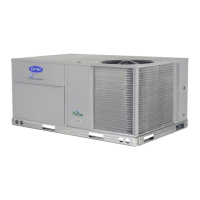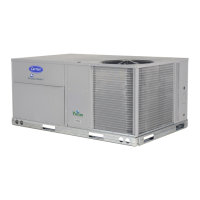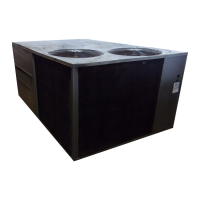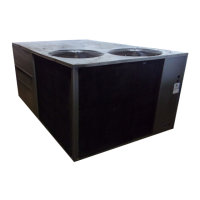16
When the space sensor has a setpoint slider adjustment, the cool
and heat setpoints (occupied) can be offset by sliding the bar from
one side to the other. The SPT Offset Range (+/--) (Setpoints
STO.R) sets the total positive or negative degrees that can be
added to the setpoints. With the slider in the middle, no offset is
applied. Moving the slider to the “COOL” side will subtract from
each setpoint, and sliding it to the “WARM” side will add to the
setpoints. The slider offset being applied at any given time is
displayed as Space Temperature Offset (TemperaturesAIR.T
SPTO).
Occupancy Determination
The building’s occupancy is affected by a number of different
factors. When the unit is operating with a space temperature sensor
(T--55, T--56, T--58 or T--59), occupancy affects the unit set points
and the operation of the economizer. If the unit is operating under
thermostat control, occupancy only affects the operation of the
economizer. If the unit’s Humidi--MiZer is being controlled by a
relative humidity sensor, then occupancy will affect the RH
setpoints. The factors affecting occupancy are listed below from
highest to lowest priority.
Level 1 Priority
Level 1 classification is a force/write to occupancy and can occur three
ways. Listed in order of priority: force on OCCUPIED, a write to
NVI_OCC, and a Linkage write. The CCN point OCCUPIED is
forced via an external device such as a ComfortIDt controller or a
service tool. When OCCUPIED is forced to YES, the unit is
considered occupied, when OCCUPIED is forced to NO, the unit is
considered unoccupied. If the 3rd party protocol LON is writing to
NVI_OCC, the control maps it to OCCUPIED as an input. If the unit
is being controlled by Linkage, the occupancy is communicated and
mapped to OCCUPIED as an input. LON and Linkage do not force
the point, only write to it, therefore a force applied to OCCUPIED
will override them.
If OCCUPIED is not being forced or written to, proceed to the
level 2 priority.
Level 2 Priority
Remote Occupancy Switch should be configured to either
Normally Open or Normally Closed when the user would like to
control the occupancy with an external switch. This switch is
field--supplied (24v, single pole, single throw [SPST]). There are
three possible configurations for the remote occupancy switch:
1. (ConfigurationUNITRM.SW = 0) No Switch
2. (ConfigurationUNITRM.SW = 1) Normally Open
Switch
3. (ConfigurationUNITRM.SW = 2) Normally Closed
Switch
If the switch is configured to No Switch (0), the switch input value
will be ignored and software will proceed to level 3 priority. For
each type of switch, the appropriate configuration and states are
listed in the table below. The Remote Occupancy Switch
(INPUTSGEN.IRM.OC) point will show the status of the
switch.
TYPE OF SWITCH
SWITCH
CONFIGURATION
STATE OF SWITCH
AND STATE OF
OCCUPANCY
Occupied when Closed
or Unoccupied when
Open
Normal Open (1)
Open and Unoccupied
Closed and Occupied
Occupied when Open or
Unoccupied when
Closed
Normal Closed (2)
Open and Occupied
Closed and Unoccupied
NOTE: To perform remote occupancy, an Economizer Control
Board must be installed in the unit.
Level 3 Priority
The following occupancy options are determined by the state of
Occupancy Schedule Number (ConfigurationCCNSCH.O
SCH.N) and the Global Schedule Broadcast (Configuration
CCN BRODB.GS).
1. (ConfigurationCCNSCH.OSCH.N = 0)
The unit is always considered occupied and the
programmed schedule is ignored. This is the factory default.
2. (ConfigurationCCNSCH.OSCH.N = 1-64)
Follow the local programmed schedule. Schedules 1 to 64
are local within the controller. The unit can only store one
local schedule and therefore changing this number only
changes the title of the schedule table.
3. (ConfigurationCCNSCH.OSCH.N = 65-99)
Follow the global programmed schedule. If the unit is
configured as a Global Schedule Broadcaster
(ConfigurationCCNBRODB.GS = YES), the unit
will follow the unit’s programmed schedule and broadcast
the schedule so that other devices programmed to follow
this schedule number can receive the schedule. If the unit is
not programmed as a Global Schedule Broadcaster
(ConfigurationCCNBRODB.GS = NO), the unit
will receive broadcasted schedules from a unit programmed
to broadcast this schedule number. While using the
programmed schedule, occupancy can be temporarily
switched from unoccupied to occupied by pressing the
override button for approximately 3 seconds on the T--55,
T--56, T--58 or T--59 space temperature sensor. Override
will only occur if SPT Override Enabled (Configuration
CCNSCH.OOV.SP) is set to YES. The length of the
override period when pressing the override button is
determined by the Override Time Limit (Configuration
CCNSCH.OOV.TL). The hours remaining in
override is displayed as Timed Override Hours
(ConfigurationCCNSCH.OOV.EX). This point can
also be changed from the local display or network to set or
change the override period length.
Indoor Fan Operation
The indoor fan is required for every function of the unit and has
several configurations that effect its operation. The Indoor Fan
Type configuration (Configuration I.FAN FTYP)setsthe
type of fan and how it is controlled. These 48/50HC units can
utilize the 1--Speed (FTYP = 0) or the LEN VFD (FTYP = 1) fan
types. The Number of Speeds configuration (Configuration
I.FAN NSPD) is not used with fan types 1--Speed or LEN
VFD. The fan operation for these two fan types is explained in
detail below. For gas heating units, the IGC fan request output
(Inputs GEN.I IGC.F) is also monitored by the MBB control.
This can result in additional modification of fan delays or other
operation due to safety functions of the IGC control. See the Gas
Heating operation section for more details. If configured for IAQ
fan operation, the fan may be turned on to satisfy air quality
demands. See the Indoor Air Quality section if using IAQ (indoor
air quality) accessory sensors. The fan can only run under
thermostat or space sensor control if the System Mode (SYS) status
is enabled. The fan will remain on if compressors or heat relays are
ever stuck on. If configured for fan status switch (FN.SW) and
Shut Down on IDF Failure is enabled (Configuration UNIT
IDF.F = Yes), the fan and unit will be shutdown without delay
on alarm. Fan off delays are honored when exiting specific HVAC
modes. The Fan--off Delay delays are as follows: Mech Cool
(Configuration COOL FOD.C), Elect Heat (Configuration
HEAT FOD.E), and Gas Heat (Configuration HEAT
FOD.G).
ComfortLINK v1.X
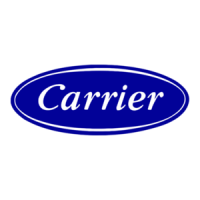
